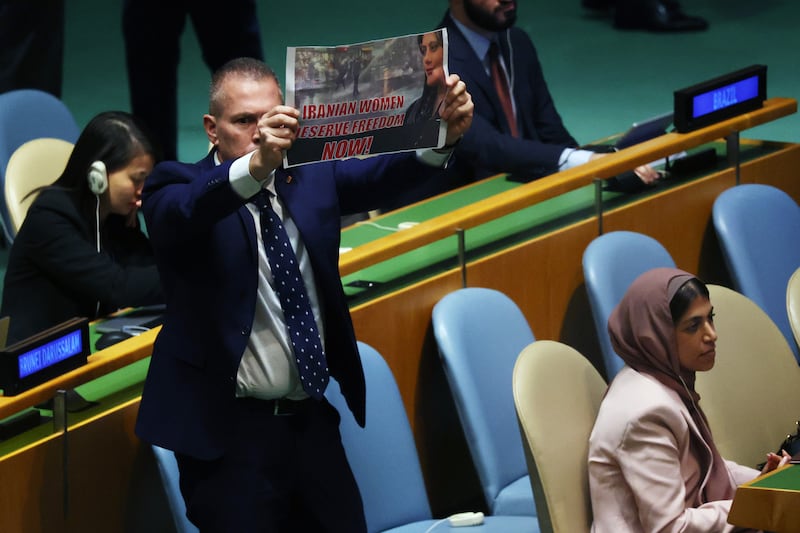The horrific, heartbreaking events in Israel and the Gaza Strip this week have seen the Islamic Republic of Iran double down on its claim to be the beacon of Islamic revolution and the most ardent enemy of Israel.
“You really made the Islamic Ummah [Muslim world] happy with this innovative and victorious operation,” Iran’s President Ebrahim Raisi said after the Palestinian group Hamas massacred at least 260 people at a rave party in southern Israel on October 7th.
Assessments of Iranian involvement in the slaughter and subsequent events, which claimed several thousand Israeli and Palestinian lives, have varied.
The White House said Iran was “broadly complicit” in Hamas’s shock offensive. The Beirut newspaper L’Orient-Le Jour reported that Iranian military leaders, including Ismail Qaani, head of the Quds Force of the Iranian Revolutionary Guards, met repeatedly with officials from Hamas, Islamic Jihad and Hezbollah in the run-up to the attacks.
READ MORE
The fact that the most radical Palestinian groups are fundamentalist Sunni Muslims or Marxists never deterred the Shia Muslim Islamic Republic from arming, financing and training them. This correspondent covered conferences in Tehran in 1991 and 2006 where Palestinian guerrilla leaders were feted like cherished children.
Iran provides $100 million (€94 million) annually to radical Palestinian groups, according to the US State Department. That is less than .03 per cent of US military aid to Israel, but it nonetheless rankles with a domestic population facing severe economic hardship.
Hamas’s abduction of an estimated 100 Israelis, civilians and military echoes Iran’s tradition of “hostage diplomacy”, which has included the detention of US diplomats in Tehran in 1979, the kidnapping of westerners in Lebanon through the 1980s, and the imprisonment of foreigners in Iran today.
Iran freed Franco-Irish citizen Bernard Phelan last May but still holds about a dozen Europeans, including a Swede from the EU’s External Action Service. Last month, Tehran exchanged five Iranian-Americans imprisoned in Tehran for five Iranians imprisoned in the US and $6 billion in frozen funds. US Republicans accuse the Biden administration of indirectly financing Hamas by paying ransom.
The hijab or Islamic head covering is, along with opposition to Israel, the other main symbol of the Islamic revolution.
Iran marked the first anniversary of the death of 22-year-old Mahsa Amini by passing the Bill to Support the Family by Promoting the Culture of Chastity and Hijab.
Amini was arrested for letting her headscarf slip and died in police custody on September 16th, 2022. About 500 protestors were killed by security forces in the ensuing riots, the most severe since the revolution.

The law was voted by the Majlis (parliament) on September 20th. It increases the maximum penalty for “bad hijab” from two months to up to 10 years imprisonment.
In what appears to be a tragic repetition of Amini’s death, a 16-year-old schoolgirl called Armita Geravand has been hospitalised in a coma since the beginning of October. She was dragged unconscious off a subway train in Tehran after she and friends boarded the train without headscarves. Critics of the regime believe Geravand was attacked by the morality police. Officials claim she fainted.
In this context, the Nobel committee awarded its peace prize on October 6th to Narges Mohammadi, a 51-year-old journalist who is serving a 10-year sentence in Tehran’s infamous Evin prison for campaigning against the death penalty.
The attribution of the peace prize to Mohammadi boosted the morale of supporters of the Woman Life Freedom movement which was sparked by Amini’s death. They had long felt abandoned by the outside world.
The Iranian government has lessened its diplomatic isolation, despite its repression of women, by allying itself with Russia in the Ukraine war, and by selling cut-price oil to China in exchange for investment under a 25-year co-operation agreement. Russia and China made Iran a member of the Shanghai Cooperation Organisation in July and in August invited Tehran to join the Brics (Brazil, Russia, India, China and South Africa) trading bloc.
China mediated the resumption of diplomatic relations between Shia Iran and Sunni Saudi Arabia last March. In another victory for Tehran, the war between Hamas and Israel is almost certain to end Saudi crown prince Mohamed bin Salman’s attempts to establish relations with Israel.
Since Donald Trump renounced the Iran nuclear deal in 2018, Iran has increased the level of its uranium enrichment from 3.7 to 60 per cent, much closer to the 90 per cent required for weapons-grade uranium. Experts believe Iran could produce sufficient fissile material for a nuclear warhead in two weeks.
There is a danger that the Hamas-Israel war could escalate into direct confrontation between Iran and Israel. “We do not want this to broaden, and the idea is for Iran to get that message loud and clear,” the US chairman of the joint chiefs of staff Gen Charles Q Brown said on October 9th.
The last major conflict between Hezbollah, Iran’s proxy army in Lebanon, and Israel, occurred in 2006. This week saw limited skirmishes between them, but renewed fighting across Israel’s border with Lebanon could trigger a larger conflagration. One can only hope that all sides will want to avoid that.















